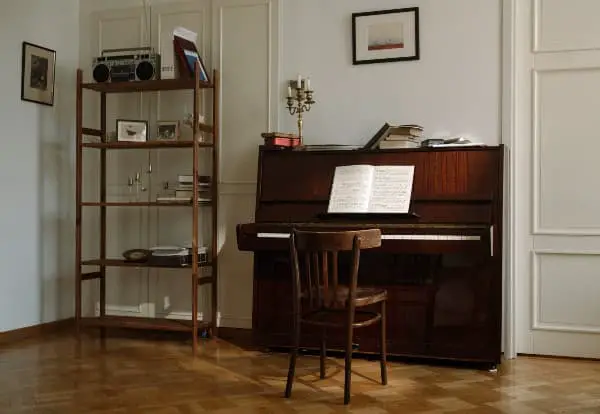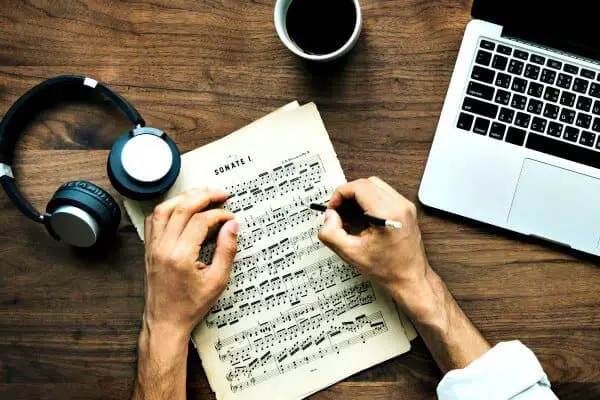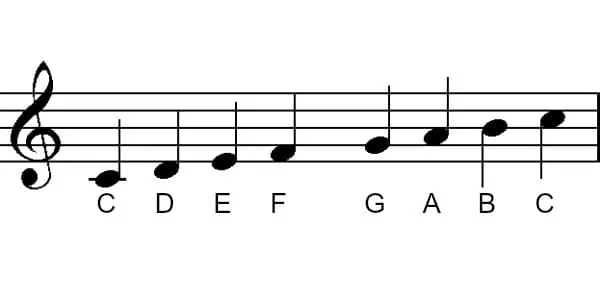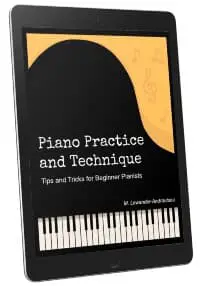- Home
- Learn to Read Music
- How to Read Piano Music
How to Read Piano Music for Beginners
This article may contain compensated links. Please read the disclosure for more info.
Would you like to learn how to read piano music better? Here is a piano lesson for beginners with tips and tricks to make note reading easier.
Learn How to Read Piano Music by Patterns
The skill of reading piano music fluently is important to master as you are studying a new piece of music. This process starts with decoding the music notes, or rather the patterns of the musical notes in the composition.
Remember that this process of learning the notes is just one of many, and knowing how to read the notes of a piece doesn’t actually mean you know the piano piece yet.
But ultimately, we want to master learning the notes of a composition as quickly as possible, so we can focus on expression, how to interpret the piece, and creating music!
How to Read Piano Music
How Hard is it to Learn to Read Piano Music?
The good news is that there are tricks to learn to read piano music easier. Some piano students seem to grasp this instinctively; that notes should be read as patterns or clusters of patterns instead of single notes. Like when you read words and sentences.
Each pattern represents a hand or arm movement as well as a typical fingering. Much like reading words- when you scan through a text, you read words, not letters, and sentences more than each word at a time.
Seeing the notes as groups, as “words” or “sentences” makes it easier for your brain to quickly decode what it means to play this pattern. Reading note by note (letter by letter) makes learning slow and gives you no sense of context.
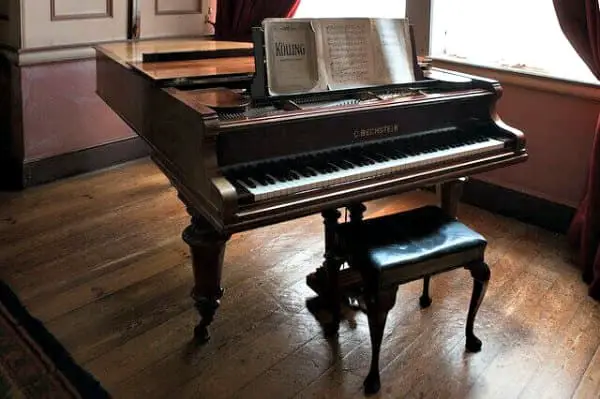
Learn How to Read Piano Music
Step By Step
Step 1
When learning how to read piano music notes, we can observe that piano music consists of three basic groups of patterns:
- Scales
- Chords
- Intervals
That is only three groups. Each group of patterns represents millions of possibilities, of course, but it is still just three groups.
- Start by studying each group separately as technical exercises
and learn about the fingering and how the pattern of each scale, chord,
arpeggio, and interval looks like both with the notes, and on the piano
keys.
Tip: A "scale pattern" has only steps* moving up or down, a repeat here and there is OK, but end your exercise where there is a skip, which you should practice as an interval. (*Unless it's a scale with larger steps like the harmonic minor.)
Step 2
Now pick an easy piano piece, and look at the patterns you see. If you have a photocopy, you can be ruthless in marking with color all you see.
- I would suggest picking one color, let’s say green, for scales.
- Circle or mark clearly the beginning and end of any scale patterns that you can find.
- Mark or circle all intervals with, say, blue.
- Finally, circle all chords (broken and blocked), or arpeggios, with red.
- Now, identify each scale, chord, or interval.
I have done that to show you in this famous Sonatina in C major by Clementi: (Click here to get a free PDF).
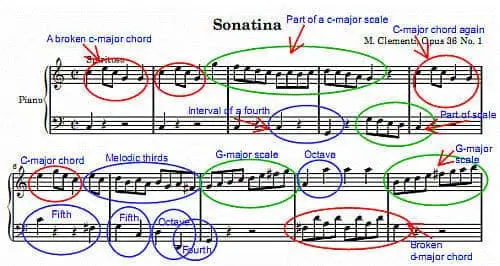
All of a sudden, you will see the piece in a new light! Instead of a bunch of un-identified notes in a forest of black and white, you can see patterns and shapes of only three concepts; scales, chords, and intervals!
Your brain will "like" this very much! And apart from making it easier to learn how to read piano music faster, it will be easier to memorize later as well.
Step 3
Now play and practice each color group.
Try to find repeated patterns of the same thing (Yay, bonus!) or similar patterns that you still play using the same technique.
But wait! Music is Rhythm too, and all those other markings everywhere and the pedal, and, and…!!
True. But you can’t do it all at once, can you?
When you learn how to read piano music, you need to prioritize.
The shapes, patterns, outlines, and what fingers to use in the piece are what you need to get your hands on first, literally.
This will be stored in your “motor memory” and controlled by a part of your brain, often called the reptilian brain. This can then be put on “auto-pilot” when you learn and add more intellectual concepts like dynamics, tempo, etc.
So, make sure to secure these movements (including the fingering) first. Rhythm is your immediate next step, and then other areas are added for each repetition.
How to Prioritize What to Focus On First
Since you can't do it all at once, you need to prioritize. Here are suggestions on two levels in the order that is best to work with when learning how to read piano music:
For beginners starting out in five-finger positions, first work on:
- Notes. Observe how they move in steps (part of a scale), skips or leaps (intervals), and repeated notes.
- The Rhythm.
- Dynamics, loud or soft.
- Articulation, staccato or legato.
- Piano pedaling, if used.
- The Character of the piece; happy, sad, funny, dreamy, etc.
Start practicing a piece focusing on one aspect at a time:
- The note names should be sung along, the rhythm should be clapped before playing and counted while playing (after learning the notes).
- At first, practice slowly, legato, and mezzo forte (medium loud), as it helps you to play more securely.
- Then add dynamics, articulation, pedal if used, and finally start playing in the correct tempo.
For a bit more experienced players prioritize like this:
- Notes, and how they move in patterns of scales, chords, and intervals. You must also immediately decide on the best fingering. This gets stuck at once, so make sure it is the best fingering for each pattern!
- Rhythm, clap and count or better yet, use rhythm-solfege (spoken rhythm like; ta-titi, etc) for shorter note values than quarter notes.
- Articulation: Staccato, Legato, Portato etc.
- Dynamics.
- Pedal.
- Phrasing.
- Tempo and tempo changes.
- Ornamentation, if used.
- Interpretation, style, etc.
At first, practice slow, legato, and mezzo-forte (medium loud), as it gives you a more secure playing.
Then add each new “ingredient” gradually as you master the previous. Of course, sometimes you do more at once. Like when you work on phrasing, as it's interconnected with dynamics.
And all the above are interconnected in the interpretation and expression of the piece. Integrating the parts into a whole is the whole idea ;)
